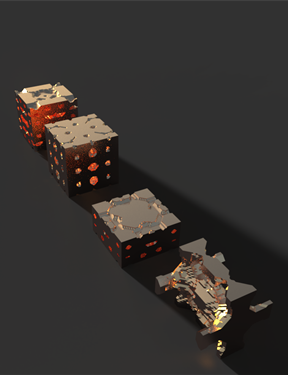The University of Pittsburgh (Pitt), an ACE member, is using artificial intelligence (AI) to reimagine infrastructure design in a pair of innovative projects.
Government investment in infrastructure
has plummeted, and much of the country’s infrastructure has fallen into disrepair. Over 42 percent of roads are in
poor or mediocre shape, and tens of thousands of bridges are
structurally deficient, according to research from the American Society of Civil Engineers.
Soaring infrastructure costs have deterred agencies from making these needed repairs.
Two projects at Pitt, the first of their kind according to an
article in Pittwire, aim to exploit AI to design infrastructure that is both more durable and more affordable. Both involve the formulation of metamaterials, or materials that are engineered to have certain characteristics. One project is focused on creating lighter, stronger concrete blocks made of metamaterials for bridges and roadways, while the other is developing metamaterial highway walls that reduce noise pollution and absorb vehicle emissions. Central to both efforts is a generative AI algorithm based on natural evolution built by Amir Alavi, a civil and environmental engineering professor who is leading the projects.
The algorithm starts with a few material unit cells with very simple shapes. Then, in a process that mimics evolution, it combines pairs of units, producing offspring with traits from each of the parent units as well as random mutations. The program simulates natural selection, favoring offspring with particular properties, like a certain level of strength. This process repeats over and over, generating numerous options and rating them by cost and other attributes of interest. The result of this evolutionary process is a suite of intricate unit cells—for the bridge project, these would be concrete blocks with different shapes and levels of rigidity—that could be assembled to form metastructures.

Sample concrete blocks designed by the AI algorithm
“We’ve accelerated the process of evolution. We can find new materials in a couple of days—materials that could have taken 10 million years to form and evolve in nature,” Alavi told Pittwire.
The goal of the bridge project is to produce metamaterial concrete blocks in new shapes that are sturdier and use less material than those currently in use. The Pennsylvania Department of Transportation plans to build a new bridge with these blocks.
The AI algorithm has yielded designs that would appreciably lower construction costs by using up to 30 percent less concrete. Some are also considerably more flexible and damage-resistant. The designs come in a variety of irregular shapes featuring holes, grooves, or other forms of negative space.
“Some of these structures are just so complex and inconceivable by the human mind,” Alavi said. “Yet, they provide excellent mechanical performance, better than all the other solutions we’ve come up with before.”
The other project, a partnership with the Pennsylvania Turnpike Commission, intends to design a wall that would minimize the impact of highways on the neighborhoods around them. Programming the algorithm to select for materials that absorb sound and pollutants has returned options that could slash noise pollution by 90 percent and nitrogen oxide pollution by 80 percent. Like the concrete designs, the models the algorithm has produced for the wall are cost-effective, making ample use of negative space.
Evolutionary algorithms have the potential to transform sectors from medicine to agriculture and more, giving people access to tools and materials that are literally beyond their imagination.
Alavi is confident that his projects are merely the first of many like them, he told
The New York Times. “After 10, 12 years, this is going to change our lives,” he said.
Photos courtesy of the University of Pittsburgh and Tom Altany
